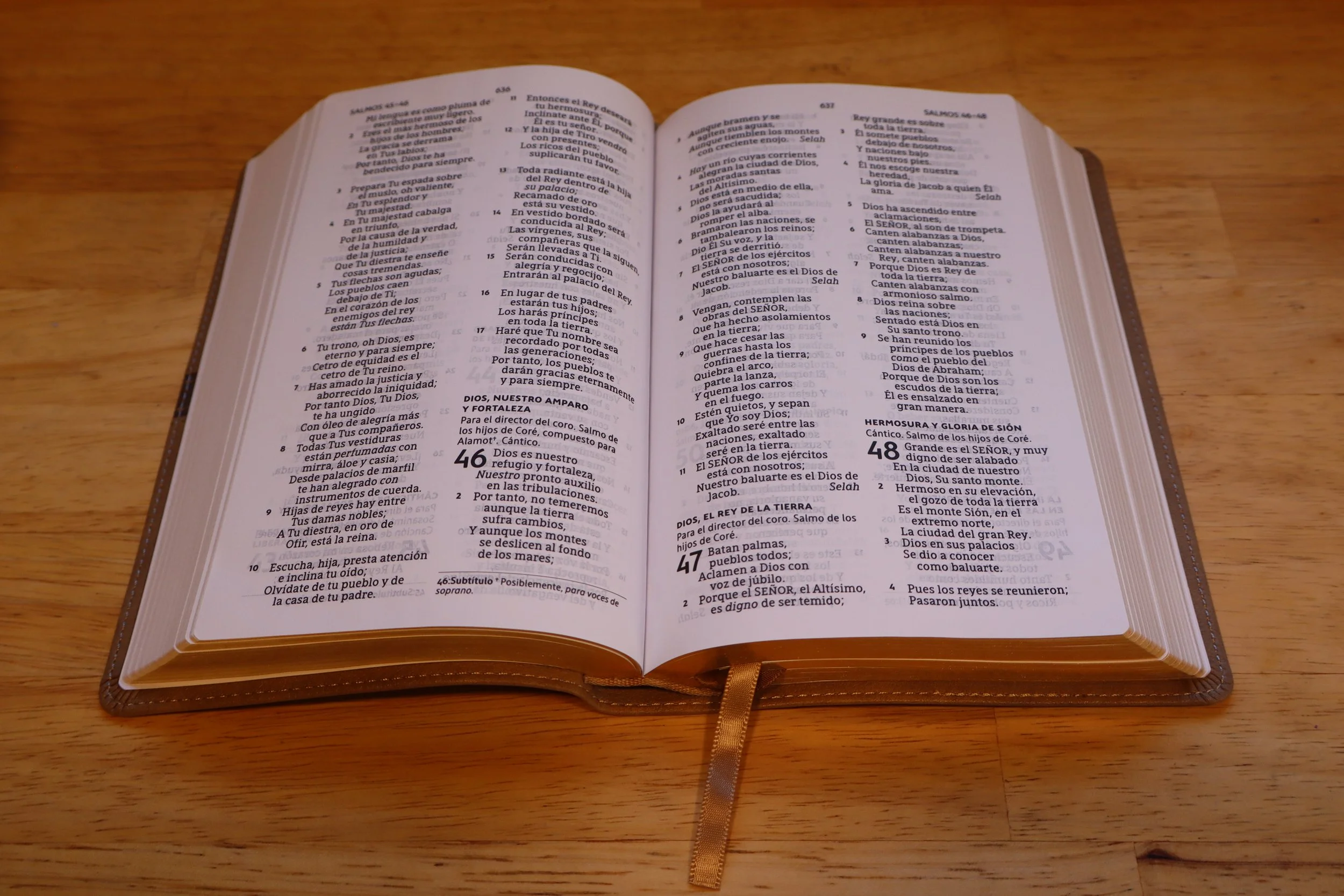The Benefits of Using the NBLA (Nueva Biblia de las Américas) Translation of the Santa Biblia
The NBLA is a project by The Lockman Foundation, which also produced the New American Standard Bible (NASB). It's designed to provide a translation that's both literal and understandable in modern Spanish, particularly for Latin American audiences.
While the Reina Valera has been a reliable translation, it reflects the textual scholarship of its time. The NBLA, however, benefits from the latest advances in biblical studies, archaeology, and manuscript discoveries. It provides a more accurate reflection of the original Hebrew, Aramaic, and Greek texts.
The Nueva Biblia de las Américas (NBLA) is a modern, faithful translation of the Bible in Spanish that has gained popularity among Spanish-speaking Christians worldwide. Published in 2020 by The Lockman Foundation, the NBLA is designed to offer clarity, accuracy, and fidelity to the original biblical texts. Below are some key benefits of using the NBLA translation of the Santa Biblia:
Faithfulness to the Original Texts
The NBLA stands out for its commitment to accurately translating the original Hebrew, Aramaic, and Greek manuscripts. It adheres to a formal equivalence approach, prioritizing a word-for-word translation while maintaining natural readability in Spanish. This faithfulness ensures that readers can study the Scriptures with confidence that the text reflects the intended meaning of the original authors.
Example:
NBLA Translation of John 1:1:
“En el principio existía el Verbo, y el Verbo estaba con Dios, y el Verbo era Dios.”
This precise rendering captures the theological depth of the original Greek text while maintaining clear and elegant Spanish.
Theological Precision
For students of theology, pastors, and lay leaders, the NBLA offers theological accuracy that is essential for teaching, preaching, and personal study. The translation avoids paraphrasing and instead conveys the nuanced meanings of the original texts. This precision is particularly valuable in key doctrinal passages where exact wording is crucial for understanding.
Example:
In Romans 5:1, the NBLA emphasizes justification by faith:
"Por tanto, habiendo sido justificados por la fe, tenemos paz para con Dios por medio de nuestro Señor Jesucristo."
The careful choice of words emphasizes the believer's new standing before God.
Modern, Clear Language
While remaining faithful to the original texts, the NBLA employs modern Spanish, making it accessible to contemporary readers. Unlike older translations that use outdated or regionalized language, the NBLA speaks to a broad audience of Spanish speakers across various countries and cultures. This clarity enhances comprehension and makes the Bible more approachable for new believers and seasoned readers alike.
Consistency with the NASB
The NBLA is closely aligned with the New American Standard Bible (NASB), one of the most respected English translations known for its literal accuracy. This consistency is a significant benefit for bilingual readers who study both Spanish and English Bibles. It allows them to cross-reference and compare texts with ease, deepening their understanding of Scripture.
Useful for Academic and Devotional Study
Whether you are engaging in scholarly research or personal devotions, the NBLA offers a rich resource. Its balance of accuracy and readability makes it suitable for in-depth Bible study, expository preaching, and devotional meditation. The translation's reliability ensures that readers can meditate on the Word with confidence and apply it to their daily lives.
Accessible Digital and Print Formats
The NBLA is available in various formats, including print editions, digital versions, and audio Bibles. This versatility allows readers to access the Scriptures on different platforms, whether they prefer a traditional Bible or a mobile app. Additionally, the NBLA is increasingly being integrated into Bible study software, making it a valuable tool for serious Bible students.
Bridging Generations and Cultures
The NBLA’s modern language and accurate translation make it an excellent choice for both older generations familiar with traditional translations and younger readers seeking a version that speaks to them in contemporary Spanish. It bridges the gap between different age groups and cultural backgrounds, fostering a unified understanding of God’s Word within Spanish-speaking communities.
For centuries, the Reina Valera has been the cornerstone of Spanish-language Bibles, beloved for its beauty and historical significance. First published in 1569 and revised in 1960 and 1995, the Reina Valera (RV) has shaped the faith of millions. However, with the evolving nature of language, modern readers may find some of its expressions outdated or difficult to understand. This is where the Nueva Biblia de las Américas (NBLA) offers distinct advantages.
Language Clarity and Readability
The Reina Valera uses formal, archaic Spanish, which can be challenging for readers unfamiliar with older grammatical structures and vocabulary. Phrases such as “vosotros,” “hiciereis,” and “andad” are less common in contemporary Spanish.
In contrast, the NBLA employs modern, clear language that resonates with today’s readers. It avoids outdated terms while maintaining fidelity to the original texts, making it easier for people across different Spanish-speaking countries to understand.
Theological Precision
The NBLA prioritizes theological clarity, ensuring that doctrinally significant terms and phrases are translated accurately. This is particularly important for teachers and students who rely on precise wording for exegesis and theological study.
Example:
In passages discussing justification, sanctification, or salvation, the NBLA carefully preserves the distinctions between these concepts, whereas the Reina Valera sometimes uses less precise language.
Modern Cultural Relevance
The NBLA is designed with the contemporary reader in mind, making it especially valuable for younger generations and new believers. Its language is culturally neutral, avoiding regionalisms or phrases that might alienate readers from different Spanish-speaking countries.
While the Reina Valera remains a treasured translation for many, the NBLA offers modern readers an accurate, clear and theologically precise alternative. For those seeking to engage deeply with God’s Word in a language they can easily understand, the NBLA is a valuable resource that bridges the gap between ancient truth and modern life.
The Nueva Biblia de las Américas (NBLA) is a highly regarded Spanish translation of the Bible, known for its accuracy, clarity, and faithfulness to the original Hebrew, Aramaic, and Greek texts. This article delves into the features, methodology, and significance of the NBLA for Spanish-speaking Christian communities around the world.
Key Features:
Literal Translation: Like its English counterpart, the NASB, the NBLA follows a formal equivalence approach, aiming to translate word-for-word from the original languages as much as possible while maintaining readability in Spanish.
Modern Spanish: It uses contemporary Spanish vocabulary and grammar, making it accessible to Spanish speakers across different regions, with a particular focus on Latin American usage. For instance, it uses "ustedes" instead of "vosotros" for the plural "you."
Inclusiveness: The NBLA is crafted to be inclusive of various Christian denominations, aiming for theological neutrality where possible, although it's based on Protestant canon.
Scholarly Foundation: The translation process involved scholars from multiple countries in Latin America and the United States, ensuring a broad representation of Spanish-speaking cultures and theological perspectives.
Study Aids: Some editions of the NBLA come with study notes, cross-references, and other tools to aid in understanding and application of the text.
Significance in Spanish-Speaking Christianity:
Accuracy and Fidelity: The NBLA is celebrated for its fidelity to the original biblical languages, which makes it a preferred choice for those who prioritize a close rendering of the Hebrew, Aramaic, and Greek texts.
Widespread Use: It's used in personal devotion, church services, and academic settings, offering a reliable Spanish text for Bible study, preaching, and theological education.
Cultural Relevance: By adopting a language style that resonates with contemporary Spanish speakers, particularly in Latin America, it bridges the gap between ancient texts and modern life.
Methodology and Translation Process:
Based on Original Languages: The translation team worked directly from the Biblia Hebraica Stuttgartensia for the Old Testament and the Nestle-Aland 27th edition for the New Testament, ensuring authenticity.
Commitment to Clarity: While maintaining a literal approach, care was taken to ensure the translation was clear and comprehensible, balancing between literalness and natural Spanish expression.
Review and Revision: The NBLA underwent multiple reviews by scholars to refine accuracy, readability, and cultural appropriateness.
The Nueva Biblia de las Américas stands out as a testament to the commitment to providing Spanish-speaking believers with a translation that respects the original text's nuances while speaking directly to the heart in a language they live and breathe. Whether for personal use, in church settings, or for scholarly pursuits, the NBLA has carved a niche as a reliable, clear, and faithful translation, contributing significantly to the spiritual life of countless individuals across the Spanish-speaking world.
The Nueva Biblia de las Américas (NBLA) offers a compelling combination of accuracy, clarity, and modern language, making it an invaluable resource for Spanish-speaking Christians. Whether for personal devotion, teaching, or theological study, the NBLA equips believers to engage deeply with the Scriptures and grow in their faith.


